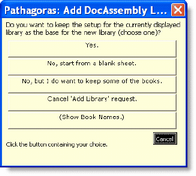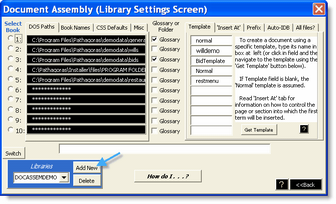Creating a New Library
At the beginning of this section of the Manual, it is important to remember that Pathagoras points. It doesn't create, move or capture, and it doesn't destroy. When you create a Library or a Book following the steps below and in other sections, you are simply memorializing or categorizing locations. You are not changing any physical property of any of your documents, or changing any content within those locations. Therefore create your Libraries and Books with full confidence that if you end up not liking what you have created, you can ditch the current iteration, and start over (or easily edit) your work. You will not ever have affected any document or folder on your computer. |
You should create a new Library when you are ready to organize your form documents (the ones that you will use for document assembly) into more logical groupings. You should also create a new Library when the current Library is 'full.'
•For example, in a law office, you may wish to have a separate Library for each major practice areas. The Books within each Library would contain both boilerplate and boutique text needed to build documents on a specific topic.
oYou might first create an Estate Planning Library, populated with books of clauses on the following topics: Wills, Trusts, Powers of Attorney, etc.
oYou might create a second Library called "Contracts." Books in that library might be titled Real Estate (Commercial); Real Estate (Residential); Purchase Agreements, etc. Pour appropriate clauses into each Book.
•There are no 'right' or 'wrong' configurations. Your office needs will drive the assignments of Libraries and the Books placed inside of them.
To create a new library:
1.Click the Document Assembly icon:
Figure 1. The Pathagoras Toolbar
The Libraries & Books screen appears.
2.Drop down the list (near top of screen) of available Libraries.:
Figure 2. Initial Document Assembly Screen: "Libraries & Books"
3.Select <<Add New Library>>. The following screen will appear:
4.Provide a name for your new Library in the screen. After you click OK, the Document Assembly 'Settings' screen will appear, showing the previous Default Library's settings (Figure 3). It will then lay over that a screen (Figure 4) asking how much, if any, of the previous Library's settings you wish to keep.
Figure 3. Document Assembly Settings screen
Figure 4. Let Pathagoras know which elements of the 'old'
Library's Settings (if any) you want to carry over to your new Library
5.Pathagoras now wants to know how much of the current Library’s books you wish to preserve. (Figure 5) Click the top button if you want to preserve the current setup. (If you preserve the current setup, you can change any setting later.) If you want none of them, click the second entry and your new library will be empty. For this example, click the second button down and let's start 'from a blank sheet.'
You now have (at least) two Libraries: (1) the original DocAssemDemo Library, and (2) the one you just created plus any Libraries you created earlier. The one you last created will be the new 'default' Library.
You can see all Libraries, and choose among them, by clicking the drop-down list under the words "Current Library" in the Libraries & Books screen (Figure 2 above). The last Library selected will become the new 'default' library.
Alternative method: You can add a new Library directly from the Settings screen. Click the Settings button in the lower right corner of the Document Assembly screen. Then, when the Settings screen appears, click the Add New button and follow the prompts.
Figure 5. Instead of adding a new Library from the initial Document Assembly ('Libraries & Books') screen,
you can activate the Setting screen and click the 'Add New' button there. The remaining steps are identical.






